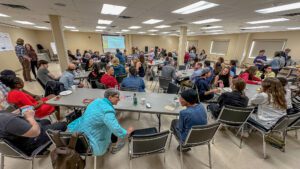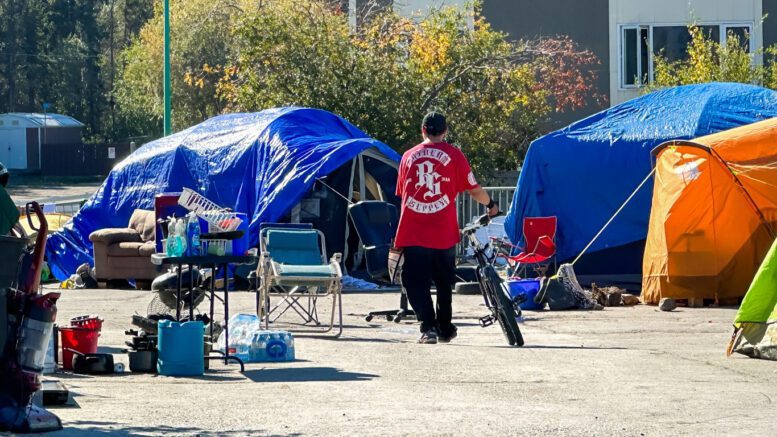After a turbulent summer last year of chasing homeless encampments and the associated illegal activities around Yellowknife, the territorial government will allow tents to be set up on its land.
Announcing on the weekend it “is aware” of what appears to be the first encampment of the season, the GNWT’s new policy is to welcome — or at least tolerate — camping in wooded areas on Commissioner’s land in and around the city.
“We understand the concerns that may arise when encampments appear in the community,” state a public service announcement issued Sunday by Housing NWT.
“These situations reflect complex social and personal challenges, and our response must be compassionate and respectful.
“The GNWT’s approach continues to focus on delivering wraparound supports, increasing transitional housing options, and working with community partners to build long-term, person-centred solutions.”
But for now, temporary tents on Commissioner’s land in surrounding wooded areas are allowed, “provided applicable regulations and bylaws are followed.”

Approximately 100 people attended a Homeless Roundtable at the Tree of Peace in Yellowknife last summer. (CKLB files)
The GNWT stated that means maintaining clean sites, no building of permanent structures, respecting shared use of public land, and complying with fire and waste safety guidelines.
Last summer and into the fall, a large collection of tents and tarps occupied a parking lot beside the Aspen Apartments, which was closed pending renovations this year into affordable/transitional housing.
Great Slave MLA Kate Reid told an Assembly committee of utility thefts, open sex acts and drug deals, and public defecation — the latter mostly in the first dozen days before the GNWT provided portable toilets.
Another encampment near the NWT Legislative Assembly Building caught fire last summer, destroying personal belongings of two Yellowknifer campers and scorching surrounding vegetation.

Premier R.J. Simpson, top left screen, briefs Assembly committee on homeless encampment on September 6th. (CKLB files)
In a summer when residents were under off-and-on fire bans due to dry conditions, the fire department response to the tent and wooden pad structure fire was large and forced the closure of 48th Street for hours.
Also last summer, a woman was held against her will by a man brandishing a weapon for one week in a tent, Yellowknife RCMP reported.
The exact location of the tent wasn’t released, but RCMP stated it was on public land. The 47-year-old suspect was also out on bail for unknown other charges.
Premier R.J. Simpson had been shepherding the Homelessness Strategy until handing it off in March to Housing Minister Lucy Kuptana in her capacity as Minister Responsible for Housing NWT.
MLAs from communities outside of Yellowknife last summer questioned if enough is being done to allow people to stay in their home communities, either with shelters but preferably through more housing.
George Nerysoo is MLA for Mackenzie Delta said, “it has to come to the communities to try to help resolve this, these social development problems.”
Then-Yellowknife Mayor Rebecca Alty said ideally the communities would be able to keep their people there, “especially the younger people who might end up here, getting into trouble and all that.”
“So they end up here, a lot of times, and that’s not the best situation,” said the mayor.
Since mid-winter, CKLB has tried to determine if there would be a new policy that would respect the people choosing to live outdoors and also the residents and visitors to Yellowknife.
City officials repeatedly pointed the finger to the GNWT, saying it was up to the more senior level of government to act.
Some recent developments:
- Housing NWT, the City of Yellowknife, and the Canada Mortgage and Housing Corporation are building a new 50-unit public housing complex on 50 Street, across from the Yellowknife Visitor Centre, between the Gold Range Bistro and the Raven Pub. The project is expected to be completed in the fall of 2026.
- The GNWT its establishing a temporary transitional housing facility just outside Yellowknife, on Highway 3 across from the Yellowknife Airport and adjacent to the parking lot used for the annual Folk on the Rocks festival. It’s not known exactly when the 25-person facility will open.
- A $2 million partnership between Ottawa and the territorial government announced over the winter to help alleviate capacity challenges, “while addressing encampments and helping find homes for people sleeping in tents through a “human rights-based and housing first approach.”
Indeed, the GNWT stated on the weekend that emergency shelter services remain available.
Since October 2024, the average occupancy rate for emergency shelters in Yellowknife has been 87%, and total shelter capacity has not been exceeded at any time.
“While shelter spaces are available and encouraged, we recognize that some individuals may choose not to access them, and we are actively working with partners to identify and address the barriers that prevent people from doing so,” stated Housing NWT’s weekend release.
“We understand the concerns that may arise when encampments appear in the community. These situations reflect complex social and personal challenges, and our response must be compassionate and respectful.”
Last summer, many homeless campers told GNWT and NGO workers they have been barred from shelters for violent behaviour or just didn’t want to be subject to searches for drugs or alcohol. Some have difficulty finding housing as they were just released from jail, or haven’t any proper identification.
The GNWT’s latest advice for residents “with specific public safety concerns” is to contact Yellowknife Municipal Enforcement or the RCMP.
The 2024 Yellowknife Point-in-Time (PIT) Count, recently released, highlights critical shifts in homelessness patterns, documenting 327 individuals experiencing homelessness — a five-per-cent increase since 2021. Here is a CKLB synopsis of the report:
The average homeless person in Yellowknife is: A First Nations or Inuit male in his prime working years from the NWT or Nunavut, who has been homeless for a full year at least.
They are homeless most likely due to income insufficiency. Their income? A mix of income sources, with heavy reliance on government assistance and ‘informal sources.’ If work is done, it’s casual, but nothing substantial.
The average homeless person has little education, perhaps just a bit of high school. They are generally healthy – physically and without cognitive impairments — and has no mobility issues.
However, there’s a very good chance they have a mental health condition, such as depression, post-traumatic stress disorder, bipolar, or schizophrenia.
They are very likely to have addictions issues.
Their parents likely attended a residential school, but he isn’t most likely to have done so himself.
As for their future, they have a clear preference to remain in Yellowknife, but also would return to their home communities (if it’s not Yellowknife). They would return, perhaps, if there weren’t family conflicts, cost-of-living barriers, or a lack of housing/services.





